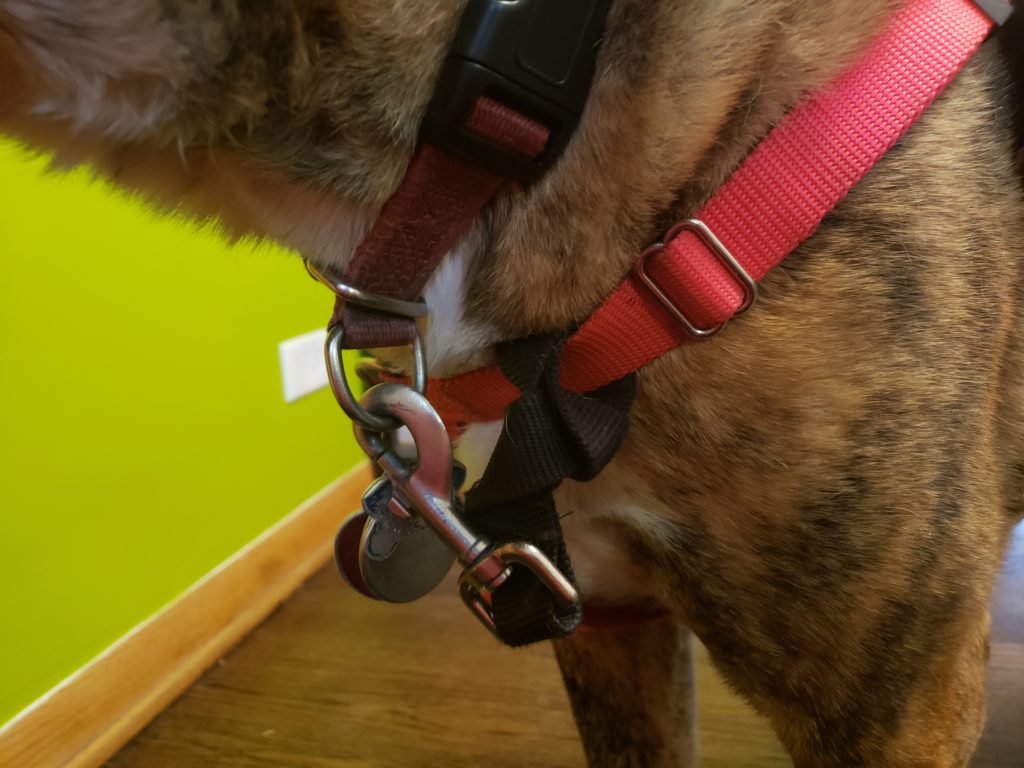Has your dog ever slipped out or almost slipped out of their harness? It’s a scary experience, and one you’re not likely to repeat! I get a lot of questions about harnesses:
Which are my favorite?
What helps with pulling?
What can my dog not slip out of?
Let’s talk about all of these!
Quick note: all product links below are Amazon Affiliate links. We receive a small commission for purchases made through these links at no extra cost to you. This helps us continue to put out free content to help you and your pets live more harmoniously!
What’s my favorite harness and what helps with pulling?
Hands down, the answer to both questions is the Freedom Harness.
I love the Freedom Harness for a few reasons:
- It fits better. This harness has more places for adjustment, which means that it fits more canine body types better. The only types of dogs that I haven’t been able to fit well in a Freedom Harness are really little dogs.
- 2 points of contact. This harness allows you to clip the leash to the chest, the back, or both the chest and back. I like that for two reasons:
- This means that one harness can serve multiple purposes. Puller? Clip to the chest. Really big puller? Clip to both the chest and the back. Sensitive throat and otherwise great on leash? Clip to the back. This is a harness that can grow with your dog, so to speak, from their days mimicking a sled dog into their golden years.
- Many trainers talk about using multiple points of contact to increase communication. While I haven’t seen research on this (yet!), I do find that clients feel like they have more control with multiple points of contact.
- It works better. My largest point of contention with most no-pull harnesses is that they’re not effective because they don’t fit well. The premise of a front-clip harness is that when the dog pulls the harness and leash will turn their shoulders, thus losing their forward momentum. But if a front clip-harness doesn’t fit well then the harness moves and the dog doesn’t and he keeps pulling forward. Because the Freedom Harness fits better I find that it works better. Plus, when you attach the leash to both the chest and back it helps the harness work even better than just clipping to the front alone.
- Side note: clipping the leash to the back of the harness allows a dog to put more of their weight into pulling forward, which usually means a sore arm for you. That’s why sled dogs use back-clip harnesses.
- Almost all of my clients love it when using it properly. I can count the clients who haven’t loved this harness on probably two hands, and more than one had Great Danes (so now I usually recommend head halters for them, even though I don’t love those as much in general). After helping my clients properly fit the harness and showing them how to use it, I’ve had very few who haven’t loved it. And at the end of the day what works best for me is what works best for the people I’m helping!
The only thing that I don’t love about this harness is the leash that it comes with, which is a leash that has one handle and two clips. Oso is a long dog and the leash was too short for him; I would trip over him when I used it. The simple solution was to just use two regular leashes.
What harness can my dog not slip out of?
That’s a harder question because the answer is: none of them. I haven’t seen a single harness that has been escape-proof. If there is one out there then the industry is keeping it a well-hidden secret!
All is not lost, though! There is a setup that can help with escape artists: safety clips and martingale collars. Martingale collars are notoriously the most difficult piece of equipment for dogs to escape from when they’re fit properly. I routinely recommend them because of this.
A “safety clip” is just something that attaches the harness (or head collar) to the collar. This is what Oso’s looks like:



His is simply a bit of leash that was cut and tied to the harness and clips to his collar. Double ended clips work well, too!
The premise is that if the dog slips out of the harness or a buckle breaks (which can happen with any plastic buckle) then the harness is attached to the collar and the collar is attached to the dog. You still get to use a harness while you’re training your dog to walk on a loose leash and you get the peace of mind that they can’t escape the setup. Win-win!
Now what?
- Be honest. Do you and your dog love your dog’s walking equipment? Why or why not? If not, double check that you’re following the manufacturer guidelines for fit and use. When I hear of people who don’t love the Freedom Harness it’s usually because they’re just attaching the leash to the back instead of attaching to both the chest and back.
- If you don’t love your dog’s walking equipment, is there something out there that would work better? Make sure that any equipment does not rely on pain, force, fear, or intimidation.
- If your dog doesn’t love their walking equipment, is there something that would work just as well that they’d like more? Have you worked on training with the equipment to alleviate their discomfort?
- Is the equipment still necessary? Many people choose to use a no-pull harness while they’re working on loose leash walking training with the goal of being able to eventually walk their dog on their flat collar alone. Others choose to use a harness throughout their dog’s life to keep strain off of the neck. Either way, consider if your equipment is still serving the intended purpose and, if not, look into something else.
- Looking for help with loose leash walking? Email us at info@petharmonytraining.com to connect with a behavior consultant!
Happy training!
Allie
P.S. This is not a sponsored post. My clients and I just really love the Freedom Harness!
P.P.S. The Balance Harness is similar to the Freedom Harness and I’ve heard great reviews, but haven’t personally used one and haven’t had clients using them so I can’t speak to them personally.



What do you do to make sure it fits totally properly?
Great question Molli! I always first recommend looking at the manufacturer’s recommendations. Each harness is supposed to fit a little differently and it’s not always intuitive as to which straps should be loosened and tightened. The manufacturere’s recommendations go into all of that! Past that, I recommend snug but not constrictive. My general rule is that you can fit a few fingers flat against their body under the harness (the number depends on how big your fingers are!) but shouldn’t be able to turn your hand.